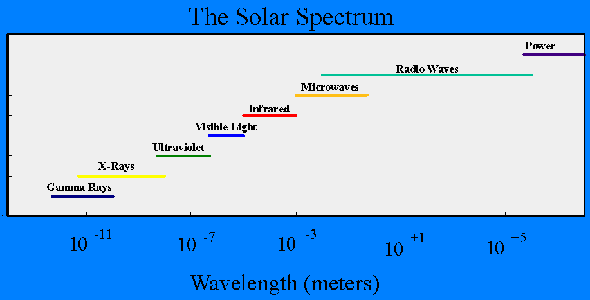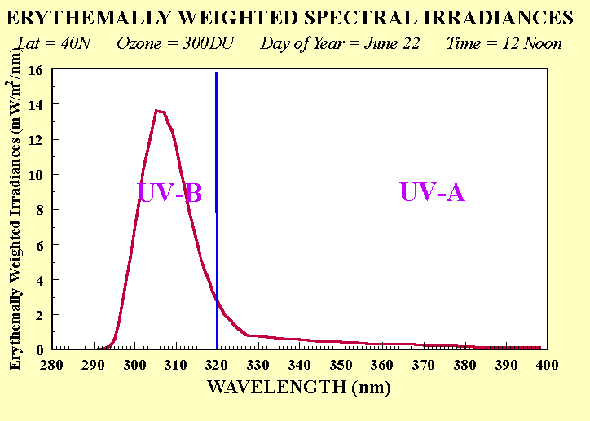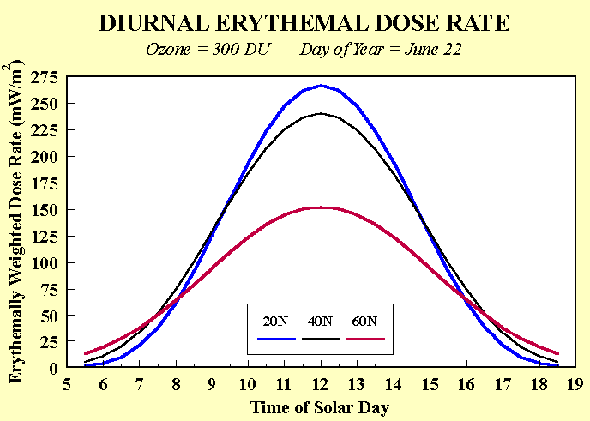Ultraviolet(UV) radiation is a specific part of the sun's entire spectrum of wavelengths Figure 1. UV radiation can be further sub-divided into three parts. UV-C is characterized by wavelengths less than 280 nm. Although highly dangerous to plants and animals, this part of the UV spectrum is completely absorbed by stratospheric ozone and does not reach the earth's surface. UV-B ranges in wavelengths between 280 and 320 nm. Ozone absorbs much of the shorter wavelength radiation, but this absorption weakens as 320 nm is approached. Plants and animals are particularly affected by this part of the UV spectrum. UV-B effects to humans are reddening of the skin (erythema) and reduction of vitamin-D synthesis in the short term, development of skin cancer, cataracts and suppression of the immune system in the long term. The wavelengths of UV-A radiation range between 320 and 400 nm. Ozone absorbs very little of this part of the UV spectrum. UV-A radiation is needed by humans for the synthesis of vitamin-D; however, too much UV-A causes photoaging (toughening of the skin), suppression of the immune system and, to a lesser degree, reddening of the skin, and cataract formation.
Figure 2 shows a plot of solar spectral irradiances (mW/m2/nm) at the surface from 290 to 400 nm for day-of-year 172 (June 22) at solar noon with a total ozone amount of 300 Dobson Units (DU). Note that the spectral irradiance increases by five orders of magnitude between 290 and 400 nm. Although the spectral irradiances drop off precipitously from 320 to 290 nm, it is in this range that the greatest changes occur in response to changes in total column ozone or in the path length that the sun's light must travel through the atmosphere to reach the surface. These changes are significant. It is at these wavelengths that plants and animals are most sensitive to UV radiation exposure. Also illustrated in Figure 1 is the standard erythemal (or sunburning) action spectrum (McKinlay and Diffey, 1987) adopted by the Commission Internationale de l'Eclairage (C.I.E.) to represent the average skin response over the UV-B and UV-A regions of the spectrum. Note how the shorter wavelengths are highly sensitive in comparison to the longer wavelengths. The erythemal action spectrum is a composite of several investigators' measurements of the response of many different human skin types to UV radiation and is not representative of any one skin type. The term "skin type" is meant to depict not only the natural pigmentation of the skin, but also the likelihood of one's skin to either burn or tan.
Figure
3 shows the net product of applying the erythemal action spectrum
to the irradiance spectrum shown in Figure 2. Note that the
peak value is near 308 nm. This peak rises (lowers) with decreasing
(increasing) amounts of total column ozone. When integrated
over the range of 290 to 400 nm, the resultant erythemal irradiance
(mW/m2) or "dose rate" indicates the instantaneous
amount of skin damaging UV radiation. This dose rate has been
observed to change by the rate of about 1.25 0.20% per one
percent change in total column ozone(McKenzie, et al., 1991),
a concept known as the Radiative Amplification Factor (RAF).
The RAF of 1.25 quoted above was determined at Lauder, NZ
(45øS). McKenzie, et al. point out that this RAF value tends
toward higher values at larger solar zenith angles. However,
the amount of UV radiation reaching the surface at these larger
solar zenith angles is much less than at smaller solar zenith
angles.
A
"dosage" value may be obtained by integrating the dose rate
over a period of time (i.e., minute, hour, day, year). Showing
how the UV dose rate varies throughout the day, Figure 4 represents
a typical mid-summer, diurnal curve of erythemally weighted
UV dose rates at 20øN, 40øN, and 60øN with the same amount
of ozone overhead. Note the rapid rise (decrease) during the
mid-morning (mid-afternoon) hours. However, during the solar
noon hour (half hour on either side of solar noon) the curve
is relatively flat. This curve becomes broader and flatter
with lower noontime values as one approaches the poles and
narrower and more peaked with higher noontime values as one
approaches the tropics.
Figure 1

Figure 2

Figure 3

Figure 4

Last Updated September 2, 1997 by Craig S. Long
Disclaimer and Reproduction Information: Information in NASD does not represent NIOSH policy. Information included in NASD appears by permission of the author and/or copyright holder. More